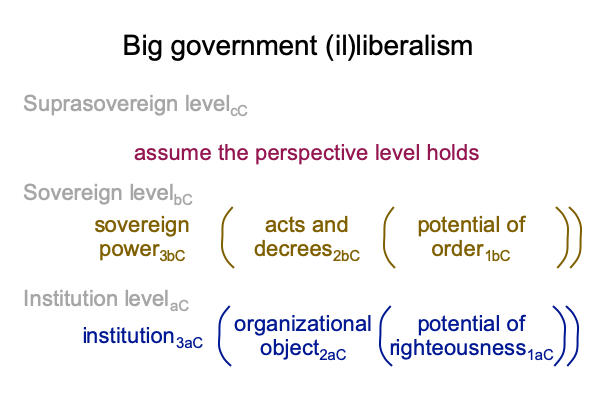The two-level interscope is typical for sensible construction. Sensible construction does not ask, “Why?”. Sensible construction assumes that, whatever we are doing, it’s okay. The perspective level is never questioned, unless something goes horribly wrong.
Here is a picture of the society tier for Big Government (il)liberalism.

If there is anything hidden within the perspective level, it is this: The milk2bC must flow1cC.
That is, the milk of the federal government2bC.
There are no suggestions for why the milk must flow, except for the fact that so many institutions3aC demand sovereign power3bC in order to implement2bC their organizational objectives2aC. Institutions3aC that do not appeal to Caesar3bCoften wither or mutate into institutions that do. Mutation is facilitated through infiltration by believers2cA in a particular (sovereign-entangling) righteousness1aC.
Each organizational objective2aC is a god.
Some call them “sacred cows”.
Since each organizational objective2aC emerges from (and situates) the potential of righteousness1aC and since righteousness1aC is inherently metaphysical in nature, the deep state consists in a wide range of cults (institutions3aC) that have a common feature. Each righteousness1aC accommodates a call for sovereign power3bC.
Diversity is the strength of Big Government (il)liberalism.
However, there is a problem.
All the advocates claim to be “not religious”, even though they are.
Why?
Why do the advocates for Big Government (il)liberalism, who congregate in cults3aC, claim to be “not religious”?
Well, the American Constitution’s first amendment states that the federal government shall not establish a religion.
Consequently, acolytes of the deep state define “religion” narrowly, with intellectual constriction, as falling into bins labeled “Christian”, “Jewish”, “Islamic” and so forth. In this way, they skirt the question that cannot be confronted. Why is their righteousness not “religious” as well? These state-entangled institutions3aC implement organizational objectives2aC that situate the potential of righteousness1aC. Why is their metaphysical righteousness exempt? Why are not they “religious”?
This crucial point is ignored by current experts in Sociology, because they are committed to Big Government (il)liberalism. Okay, that’s a cheap shot. But really, the answer demands a definition of the word, “religion”, that does not simply slap labels onto people. Do any sociological theories explain why the labels work? Or, do the labels explain themselves?
The course, How to Define the Word “Religion” offers a novel definition, one that is not hemmed in by a deep-state historical narratives or restrictive legalisms.
But wait, the indoctrinated… er, educated citizen replies, “Okay, let’s be sensible. These state-entangled institutions, and their advocates, say that they are not religious because they are not ‘Christian’, ‘Jewish’, ‘Islamic’ and so forth. This is obvious. Everyone agrees.”
Shall I venture a translation?
If you disagree, no milk for you. Instead, you will feel the sovereign’s teeth.
This is a word-game, where so-called “enlightenment” institutions3aC advocate for certain laws and decrees2bC in order to promulgate their organizational objectives2aC, yet declare themselves to be “not religious”. Why is their righteousness1aC different from the righteousness1aC of institutions that fall under the label? How do their missions2aC differ from the Christian, Jewish and Muslim missions2aC? Why do they say that they are not religious?
Oh, yes, that gets around the first amendment.
Clearly, the veiled perspective levelc of the deep state encourages subsidies2bC for innumerable “points of light”, institutions3aC that self-identify as “not religious”, yet are founded on diverse calls to righteousness1aC. These cults3aC that have a character in common. Each point of light3aC signals its virtue1aC, while demanding that state laws and decrees3bC implement its organizational objectives2aC.
The advocate-lobbyist says, “Our missions2aC are ‘not religious’, yet are necessary for the organization of a righteous society.”
The advocate-lobbyist cannot say, “There may be a reason why the organizational objectives2aC of all deep-state institutions3aC call for the exercise of sovereign power3aC. But, we cannot know the reason until the milk becomes all there is.”
Only then, will the veil be pulled back and the perspective levelc revealed.
What do we know?
Big Government (il)liberalism establishes institutions3aC that declare themselves to be “not religious”, even though, like Christian, Jewish and Islamic institutions3aC, they contextualize organizational objectives2aC that emerge from (and situate) the potential of righteousness1aC. Their declaration exempts them from the first amendment of the American Constitution.
Big Government (il)liberal organizational objectives2aC have a common feature. Their2aC implementation relies on sovereign power3bC. Since sovereign power3bC is not subject to its own laws and decrees2bC, then the resulting institutions3aC participate in the sovereign’s state of exception. In fact, the sovereign3bC is the only one who can bring contemporary trends to fulfillment by cultivating a state of exception2cC.
The federal government not only has established a host of religions3aC, each standing as a point of light in a New World Order, but all these religions3aC vicariously participate in the exception2cC that contextualizes sovereign power3aC.
What does this imply?
The theology of the deep statec is yet to enter into consciousness in our current, Enlightenment-celebrating, Zeitgeist. State-entangled institutions3aC are everywhere. Few have eyes to see. Many avert their gazes. The suprasovereign levelcC stands behind a curtain and will step out only when a state of exception2cC brings all into relation1cC. That moment will be a revelation.
There are signs of a future unveiling. The hour draws near.
Consider Comments on Peter Burfiend’s Book (2014) Gnostic America.
Consider Comments on Eric Santner’s Book (2016) The Weight of All Flesh.
These works belong to the Intimations of Political Philosophy series, available at smashwords.
Broadcaster Steve Deace reads the writing on the wall, announcing, “We are not dealing with a political party. We are dealing with a cult.”
The federal government has established a legion of religions3aC, each declaring itself to be “not religious”. Plus, each has one other feature in common with all others. Where are the intellectual tools to articulate these sociological phenomena?
